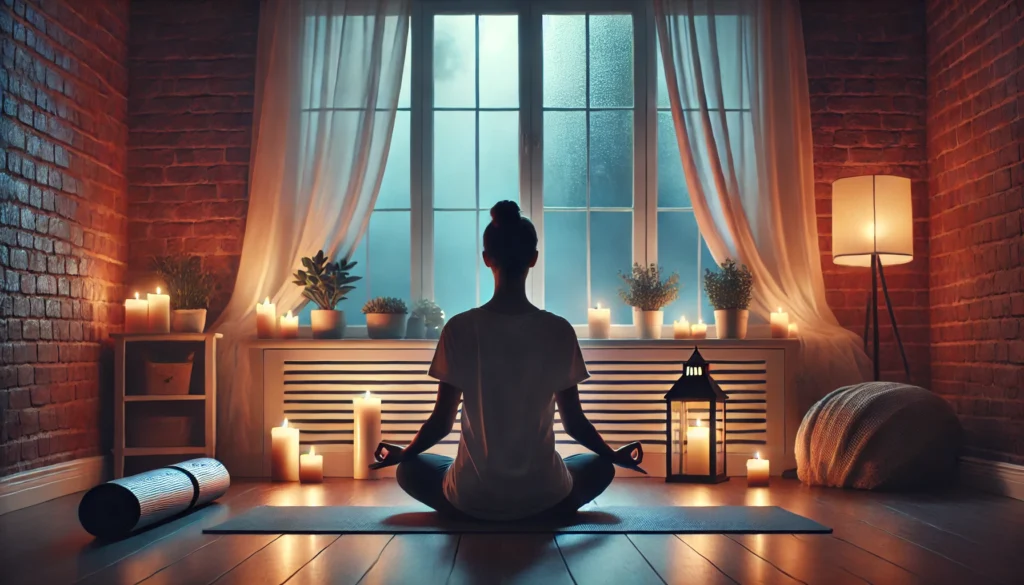In this comprehensive guide, we will explore how yoga can be harnessed to alleviate depression symptoms, the scientific basis behind its effectiveness, and practical yoga poses that can be integrated into daily routines. By weaving together historical context, current trends, and future implications, we aim to provide a well-rounded perspective on the role of yoga in mental health.
You may also like: Natural Supplements for Effective Anxiety Relief

Understanding Depression and Its Impact
Depression is a complex and multifaceted mental health disorder that affects millions of individuals globally. Characterized by persistent feelings of sadness, hopelessness, and a lack of interest in activities, depression can significantly impair daily functioning and overall quality of life.
The Global Prevalence of Depression
Depression ranks among the most common mental health disorders worldwide. According to the World Health Organization, over 264 million people of all ages suffer from depression, impacting their ability to work, interact socially, and maintain a healthy lifestyle. This prevalence highlights the urgent need for accessible and effective treatment methods.
Traditional Treatments and Their Limitations
While traditional treatments such as psychotherapy and medication are effective for many, they do not work for everyone. Some individuals experience side effects from medications, while others may not have access to therapy due to financial or geographical constraints. This has led to a growing interest in complementary therapies like yoga.
The Need for Holistic Approaches
The interest in holistic approaches is fueled by a desire for treatments that address the mind, body, and spirit. Holistic therapies like yoga provide a more comprehensive approach by integrating physical, mental, and emotional healing. This integration can lead to more sustainable improvements in well-being.
The Science Behind Yoga and Depression
Yoga, a practice that originated in ancient India, is more than just physical exercise. It encompasses a range of physical postures, breathing techniques, and meditation practices aimed at achieving a harmonious balance between the mind and body.
The Physiological Impact of Yoga
Yoga influences the autonomic nervous system, reducing stress responses and promoting relaxation. By engaging the parasympathetic nervous system, yoga helps decrease heart rate and blood pressure, creating a state of calm and reducing anxiety.
Neurotransmitter Regulation
Scientific studies have shown that yoga can increase levels of gamma-aminobutyric acid (GABA), a neurotransmitter associated with improved mood and reduced anxiety. This biochemical change can lead to a significant reduction in depression and anxiety symptoms.
The Psychological Benefits
Beyond physiological effects, yoga promotes mindfulness and self-awareness. These psychological benefits help individuals regulate their emotions, enhance their mood, and develop healthier coping mechanisms for stress and depression.
Yoga Poses for Depression Relief
Incorporating specific yoga poses, or asanas, into your routine can help alleviate depression symptoms by promoting relaxation, reducing stress, and enhancing mood. Here are some yoga poses that have been found to be particularly effective:
Child’s Pose (Balasana)
Child’s Pose is a restorative pose that helps calm the mind and relieve stress. By gently stretching the hips, thighs, and ankles, it promotes relaxation and reduces tension.
- Benefits for Mental Health: This pose encourages introspection and self-soothing, helping to release emotional tension and foster a sense of security.
- Physical Alignment and Modifications: Beginners can use props like pillows to support the torso, making the pose more comfortable and accessible.
- Mindful Breathing Techniques: Practicing deep, rhythmic breathing while in Child’s Pose can enhance its calming effects and deepen relaxation.
Bridge Pose (Setu Bandhasana)
Bridge Pose helps open the chest and improve circulation, which can have a positive impact on mood. It also strengthens the back and legs, promoting physical vitality.
- Boosting Energy Levels: The pose activates the spine, energizing the body and combating fatigue, a common symptom of depression.
- Emotional Release: By opening the chest, Bridge Pose facilitates emotional release and helps balance emotions.
- Safety and Adjustments: To ensure safety, it’s essential to align the knees with the hips and use support under the shoulders if needed.
Corpse Pose (Savasana)
Corpse Pose is the ultimate relaxation pose, allowing the body to fully rest and rejuvenate. Practicing Savasana at the end of a yoga session helps integrate the benefits of the practice and promote a sense of calm.
- Integration of Practice: Savasana is essential for absorbing the benefits of the entire yoga session, promoting mental clarity and inner peace.
- Mindfulness and Meditation: This pose offers an opportunity to practice mindfulness meditation, focusing on the breath and sensations in the body.
- Creating a Restful Environment: Practitioners can enhance the experience by dimming lights, using aromatherapy, or playing soft music.
Yoga for Depression and Anxiety
Beyond depression, yoga is also effective for managing anxiety symptoms. The practice encourages mindfulness and present-moment awareness, which can reduce rumination and worry.
The Connection Between Depression and Anxiety
Depression and anxiety often co-occur, with overlapping symptoms and triggers. Yoga’s dual ability to address both conditions makes it a valuable therapeutic tool.
Mindfulness and Present-Moment Awareness
Yoga encourages a focus on the present moment, reducing the tendency to dwell on past regrets or future worries. This mindfulness can significantly diminish anxiety levels.
Breathing Techniques for Anxiety Relief
Incorporating practices such as Pranayama (breathing exercises) and meditation into your yoga routine can further enhance its anxiety-relieving effects. Techniques like Nadi Shodhana (alternate nostril breathing) and Ujjayi (victorious breath) help calm the nervous system and improve focus.

Historical Context and Future Implications
Yoga has a rich history dating back thousands of years. Originally developed as a spiritual practice, it has evolved into a popular form of exercise and stress management worldwide.
The Evolution of Yoga
From its origins in ancient India, yoga has transformed significantly, adapting to modern lifestyles while preserving its core principles. This evolution has enabled yoga to reach a global audience, transcending cultural and geographical boundaries.
Integration into Mental Health Care
In recent years, the integration of yoga into mental health treatment has gained recognition among healthcare professionals. This acceptance is based on mounting evidence of yoga’s benefits for mental health, particularly its ability to complement traditional therapies.
Future Directions in Research
The future of yoga in mental health care is promising. With ongoing research and an increasing understanding of the mind-body connection, yoga is set to play a significant role in the prevention and management of mental health disorders. Future studies are likely to uncover even more about how yoga can be tailored to individual needs.
Practical Tips for Integrating Yoga into Your Routine
For those new to yoga, starting with a gentle practice under the guidance of a qualified instructor is recommended. Many resources, such as online classes and mobile apps, offer accessible ways to begin a yoga practice from the comfort of your home.
Choosing the Right Style of Yoga
Different styles of yoga cater to various needs and preferences. Hatha yoga is suitable for beginners due to its gentle pace, while Vinyasa offers a more dynamic flow. Exploring different styles can help you find the one that best suits your mental health goals.
Creating a Dedicated Practice Space
Establishing a serene and clutter-free space for your yoga practice can enhance focus and relaxation. Personalize your space with elements like candles, plants, or inspiring artwork to create a calming atmosphere.
Incorporating Yoga into Daily Life
Integrating yoga into your daily routine doesn’t require lengthy sessions. Short, consistent practices can be just as beneficial. Consider incorporating yoga into your morning routine to set a positive tone for the day or winding down with a gentle session before bed.
Tips for Success
- Set a Regular Practice Schedule: Consistency is key. Aim to practice yoga several times a week to experience its full benefits.
- Listen to Your Body: Yoga is a personal journey. Modify poses as needed and focus on what feels good for your body.
- Combine with Other Therapies: Yoga is most effective when used as a complementary therapy. Continue with prescribed treatments and consult with healthcare providers.
In conclusion, yoga offers a holistic approach to managing depression and anxiety symptoms. By incorporating mindful movement, breathwork, and meditation, individuals can experience enhanced mood, reduced stress, and improved overall well-being. As we continue to explore the potential of yoga in mental health, its role as a powerful tool for healing and transformation will only grow stronger.
Further Reading:
The Benefits of Yoga for Depression
Important Note: The information contained in this article is for general informational purposes only, and should not be construed as health or medical advice, nor is it intended to diagnose, prevent, treat, or cure any disease or health condition. Before embarking on any diet, fitness regimen, or program of nutritional supplementation, it is advisable to consult your healthcare professional in order to determine its safety and probable efficacy in terms of your individual state of health.
Regarding Nutritional Supplements Or Other Non-Prescription Health Products: If any nutritional supplements or other non-prescription health products are mentioned in the foregoing article, any claims or statements made about them have not been evaluated by the U.S. Food and Drug Administration, and such nutritional supplements or other health products are not intended to diagnose, treat, cure, or prevent any disease.


